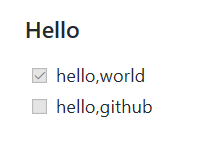每天推薦一個 GitHub 優質開源項目和一篇精選英文科技或編程文章原文,歡迎關注開源日報。交流QQ群:202790710;電報群 https://t.me/OpeningSourceOrg
今日推薦開源項目:《Checklist-Checklist 檢查表工具》
推薦理由:這並不是一個APP,而是一個提供鏈接的網站;http://checklist.yingjiehu.com/;網站中的鏈接是別人分享出來的自己實現某個目標的詳細過程,讀者能夠借鑒別人的實現過程做一個自己的規劃。
Checklist-Checklist 能做什麼:
- 增加新的,或者說你自己的 checklist
- 提議刪除不夠完善的 checklist
- 幫助設計頁面的外觀
- 修改文稿的小錯誤
- 對任意 checklist 做出修改使其更通俗易懂
- 提出對 checklist 的不同分類方法
- 用 [Title](LINK) - DESCRIPTION. 形式輸入直接指向該 checklist 的鏈接,並在新增的條目旁放一個標籤:

PS:標籤里checklist的顏色可以更改,把下面的<CODE>改成 red 、blue 等等等等:
<a href="http://checklist.yingjiehu.com/"><img src="https://img.shields.io/badge/Awesome-Checklist-<CODE>.svg"></a>
為何要用Checklist-Checklist:
- 使用checklist可以記錄下內容,通過不斷的分支統籌規劃自己的計劃
- 通過不斷完成小分支保持自己 on tack
- Even a set of basic criteria to maintain quality control or a checklist for larger projects would help.
哪怕是最基本的準則和備忘錄都能對你的工作起很大的幫助。 --沃茲基碩德
你該如何使用Checklist-Checklist:
假如你想要安裝 Ubuntu,你可以如下所示:

你所需要做的只是簡簡單單的在頁面上找到你要的鏈接,點開它,然後就可以愉快的進行閱讀了。
當然,如果你想要創建你自己的 checkist,作者也給出了一個建議:使用 Github 的 Github Flavoured Markdown 。
關於GFM:
基於 Github 的 Markdown 的衍生版本,Markdown 作為一種應用極廣的標記語言,在此便不做贅述,僅僅列出GFM與其的幾個區別:
- 不需要像標準MD里一樣每行前用4個空格對齊,只要在代碼段頭尾加上<code></code>標記便能識別出代碼段。同時還支持語法高亮。
- 可能會忽略標準MD中用下劃線「_」來實現斜體的做法,建議使用*helloworld*這種格式來實現斜體。
- 在GFM中寫URL鏈接文本能自動生成URL,並且顯示出來的也是鏈接
- 支持帶勾選框的任務列表

效果:

當然,以上只是GFM的部分特性,如果感興趣(也可能是必須)請訪問這個頁面:
https://help.github.com/categories/writing-on-github/
關於作者:
Huyingjie:統計學家,NYC數據科學家(沒照片)
Github主頁:https://github.com/huyingjie
Patreon頁面:http://www.patreon.com/yingjiehu
今日推薦英文原文:《Google Fuchsia Is Not Linux: So, What Is It and Who Will Use It?》作者:Steven J. Vaughan-Nichols
原文鏈接:https://www.zdnet.com/article/google-fuchsia-is-not-linux-so-what-is-it-and-who-will-use-it/
推薦理由:Google 的新操作系統 Google Fuchsia 已經推出很久了,大家也都一直在討論它,知道它是開源的,很多朋友一聽開源操作系統第一反應很可能就是 Linux,然而事實上,Google Fuchsia 並不是 Linux,那麼它是什麼呢?有什麼特點呢?誰會使用它呢?
Google Fuchsia Is Not Linux: So, What Is It and Who Will Use It?
Fuchsia, Google tells us in some recently revealed documentation, is not Linux. So, what is it then? And what's it good for?
Google Fuchsia: What is it and which devices run it?
Google has been working on this open-source operating system since the summer of 2016. At first, we thought Fuchsia was for Internet of Things (IoT) devices. We now know it can also power Chromebooks and smartphones.
Is it a replacement for Android and Chrome OS? Good question. It's not clear what Google plans for it. We do know it runs on Google's high-end, Chrome-OS powered Pixelbook. You can also install it on Acer Switch 12 and Intel NUC and, eventually, on a Raspberry Pi 3.
Unfortunately, on my Pixelbook, or any other platform, you can't do much with it. For now, the only thing it does on my Pixelbook is show the time. Oh, there's a real operating system there, but it has barely any functionality. This isn't even alpha software. It's still a science experiment.
Fuchsia developer Travis Geiselbrecht said in a Fuchsia IRC discussion that Fuchsia isn't "a toy thing." He added that it's not a 20-percent project -- and "it's not a dumping ground of a dead thing that we don't care about anymore." A 20-percent project is when Google developers work on something because it interests them rather than because it's part of their job.
Now that we have a look at the project's documentation, we know more about what's happening under Fuchsia's hood.
First, it's built on the Zircon micro-kernel. Besides the microkernel, it includes a small set of userspace services, drivers, and libraries. These are used to boot the system, talk to hardware, load userspace processes and run them, and not much more. The kernel manages several different Object types. Those that are directly accessible via system calls are C++ classes. Fuchsia builds on top of this foundation.
Objects are an important concept. Fuchsia is a modular operating system. This implies you'll be able to use it on both low-powered, minimal-resource devices all the way up to PCs. You simply add the object modules you'll need for each device.
We also know, since it will support a subset of Portable Operating System Interface (POSIX) conventions, from a developer's viewpoint, it will look like Unix/Linux. For all the objections about POSIX, it's held up well over the years.
Fuchsia uses Google's Flutter as its software development kit (SDK). With it, you can currently build Chrome OS and Android apps. Fuchsia also supports Apple's Swift language.
Google Fuchsia: What's all this for?
The most popular theory is to "replace Android and Chrome OS." No. Just no.
Both operating systems are popular with users and developers. Android is the world's most popular operating system. Besides, if you're a programmer, would you want to move literally over a million Android apps to a new platform? I don't think so!
Chrome OS is already the perfect Google operating system. While built on Linux, much of its functionality relies on Google services. It's also been gaining more users over the years. Why fool around with business perfection?
I also think Google's smart enough not to reinvent the wheel. This is a new operating system being built from the kernel up. It will take years before it's ready for production, never mind replacing an existing popular operating system.
I suspect Fuchsia will find its home in virtual reality, augmented reality, or other "still to come" technologies. It's not a replacement for what we already have; it's a door to a future we're not living in yet.
每天推薦一個 GitHub 優質開源項目和一篇精選英文科技或編程文章原文,歡迎關注開源日報。交流QQ群:202790710;電報群 https://t.me/OpeningSourceOrg
